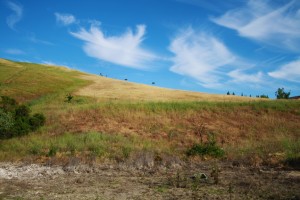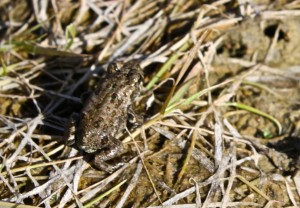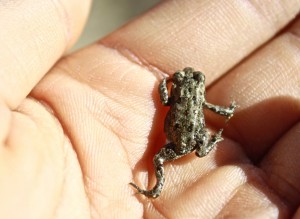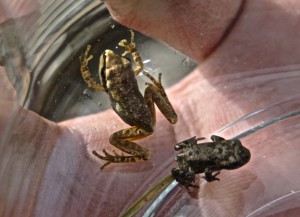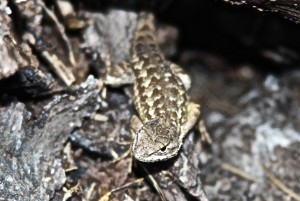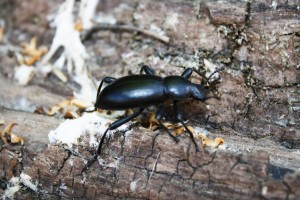An Afternoon in Lime Ridge
May 2012
It is a pleasant, sunny afternoon in the East Bay. My brother and I are on a nature hike in Lime Ridge open space, an area stretching from Walnut Creek to Concord, and home to a variety of reptiles, amphibians, birds, mammals, and insects. The landscape is a mixture of greens and browns, abundant with oak trees, shrubs, and tall grasses.
As California’s dry climate approaches the hot summer months, the spring pond has mostly evaporated, leaving behind some marshy areas of mud and grass.
Here, we noticed our first sign of movement—a tiny little shape, no larger than a thumbnail, crawling along the muddy ground. When we crouched down and looked closer, we realized it was a young Western Toad.
As we continue into the meadow, we realize the entire area – stretching as far as the eye can see – is teeming with thousands and thousands of juvenile toads, hopping around in the grass and hiding in holes in the mud. We estimated that we saw five to ten toadlets per square meter.
We collect some of them in a jar so as to observe them more closely. The amphibians remained crawling around at the bottom of the jar, except for one that nearly escapes the jar. This individual is a light-green and yellow color. It is about the same size as the juvenile Western Toad but has slightly different markings, and we noticed it is able to climb up the side of the jar, unlike the rest of the toads.
This species of the amphibian–which we have identified as the Pacific Chorus Frog (or Pacific Treefrog)–is much more sparse than the toads were. We estimated about one Pacific Treefrog for every 60 Western Toads.
You can see the difference between the two species here.
Interesting Facts:
-It is relatively easy to distinguish between a frog and toad—the differences between the two may seem subtle, but there are a few key distinctions. Although the Pacific Treefrog is nearly the same size as the juvenile Western Toad, frogs have a smooth skin surface, while toads have bumpy skin. Frogs also have webbed or padded/enlarged toes, whereas the toad does not. The frog is also an exceptional jumper—it has longer legs, so it can jump much farther distances than the toad in relation to its body length.
-Frogs actually absorb water through pores in their skin—as amphibians, they need to be in wet areas to avoid water loss and dehydration.
-The Pacific Treefrogs have an interesting quality—they are able to fluctuate between “color morphs,” ranging from brown to bright green. They can also change from darker to lighter and even shift pattern markings. These shifts in pigmentation are caused by differences in the frogs’ habitat lighting, brought about by seasonal changes. The initial transformation can be noticed immediately, and a full color morph can take from weeks to months.
-The Western Toads in lower-elevation regions such as the area we hiked) mate in the late winter to early spring, while the species in mountainous regions mate in the late spring to summer. The juvenile toads we saw, about the same size as the Pacific Treefrogs, had newly developed from s1171
tadpoles and were still small, but eventually grow to be much larger than the frogs. The toads won’t be able to reproduce until they are 2-3 years old!
-Frogs and toads are considered “indicator species”—which means that the presence of these amphibians indicates a healthy environment. Recently, these delicate and vulnerable amphibians have been in rapid decline due to climate change, pollution, destruction of their natural habitats due to construction, chemical contamination from fertilizers, etc. Lately the Bay Area has seen a lot of rain—the Lime Ridge area last year around this time was completely dry due to drought. We were excited to see so many young toads and frogs on our hike this time—it suggested a healthy habitat and thriving ecosystem.
After a few minutes, we release the Treefrog and Toads, making a mental note to visit again in a few weeks to see how the toadlets are developing.
Continuing along our hike, we spotted the Western Fence Lizard.
Interesting Facts:
-The Western fence lizard may appear dull in hue (which enables it to camouflage with the ground, rocks, or tree trunks), but the underside is a bright, metallic blue color.
When we go to exit back through the open space gate entrance, I narrowly avoid stepping on a Desert Stink Beetle! Disturbing this seemingly harmless critter would have been a big mistake…
Interesting Facts:
-This species, a type of darkling beetle, raises its abdomen when aggravated or in danger, releasing a foul stench, which it secretes from glands at the tip of its abdomen.
-Most predators avoid this beetle due to its stink and unpleasant taste, except for a few, including grasshopper mice, who avoid this by sticking its abdomen into the sand and consume it headfirst.
While crossing a cul-de-sac bordering the open space we just exited, we spot a strange looking insect that appears to have red fuzz covering its body. Its appearance gives it the common name Velvet Ant, although it is actually a type of wasp, belonging to the family mutillidae.
Interesting Facts:
-The female Velvet Ant invades the ground nests of other wasps and bees, laying its eggs on the larvae (hosts). Once the host larvae develop into their pupal form, the newly hatched velvet ants eat their hosts, spinning their own cocoons inside their hosts’ pupal cases.
-Male Velvet Ants have wings, and look quite different from the females. The females are wingless, however they are often seen as pests, as they can deliver a nasty, painful sting—earning them the nickname “cow-killer.”
As we return home from our hike, we find a California Striped Racer, also known as the Alameda Whipsnake. My neighbor spotted it slithering in our yard outside of the house.
Although usually fast and skittish, this one is relatively calm and doesn’t seem too frightened…
Interesting Facts:
-Most types of racers are a single, dull color. The California Racer is unique among many racers because it has bright yellow stripes down its body.
-California Racers are often confused with Gartersnakes, another common snake in the area with similar stripes and colors. However, they can be distinguished by the placement of the yellow stripes on their back—the garter has a stripe running down the center of its back, while the California racer has two stripes and a thick black center stripe. The Gartersnake also has rough, or “keeled” scales, whereas the California Racer’s scales are smooth.
Throughout my childhood, I was lucky enough to have grown up right next to the Lime Ridge Open Space. Since the entrance to the wildlife reserve was only a block down from my house, I’ve gone on countless nature hikes with my family, exploring the different types of species of frogs, snakes, mammals, birds, and insects. From trekking through the hills with my neighbors as a child, treading along the various wildlife trails with my family, catching insects with my brother and looking at them under a magnifying glass, my experience with the open space has occupied an integral and meaningful place in my childhood. I’ve learned a lot over the years, things you can’t learn simply from just reading books, taking a biology class or watching Animal Planet. From my many experiences and encounters—being eight years old and watching in awe as a tarantula crawled over my shoe, bringing home tadpoles each year and raising them into frogs and then releasing them back in to the wild, or thinking I was the crocodile hunter and trying to grab every snake I saw (poisonous or not)—I’ve become rather fond of the nature I grew up with, and have learned to respect all wildlife, no matter how slimy, strange, stinky or slithery.
See also this earlier trip report for Lime Ridge.
